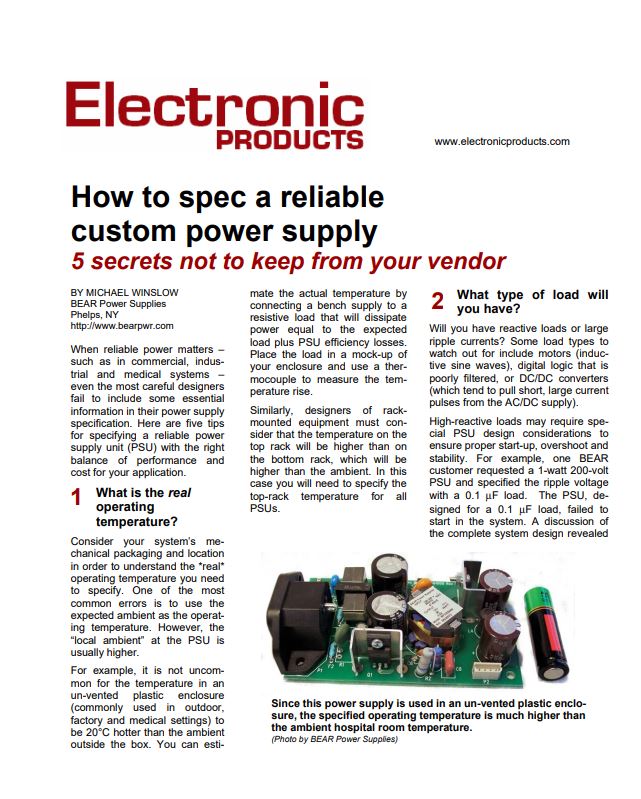
Why Custom Power Supplies?
A custom power supply can be the right option if you need:
- Small size or special form factor to fit your system.
- Rugged or extended temperature range.
- High reliability and long life.
- Special performance, such as very low noise or leakage current.
- A replacement for an obsolete COTS unit.
- Unusual output voltage(s).
Advantages of Custom Design
- You get exactly what you need rather than adjusting your system design around what’s available off-the-shelf.
- You can reduce other system components (e.g. fans) and their related costs.
- You get the greatest flexibility to optimize the overall mechanical design.
- You get a power supply to fit your space, rather than designing around a fixed form factor.
Drawbacks of Custom Design and How to Reduce your Risk
- Custom is more expensive …going custom is not the way to get a cheaper power supply unit. However, it can reduce overall system costs by reducing complexity of the rest of your board design.
- It will be sole-sourced …reduce your risk by choosing a vendor that guarantees long-term support. Bear has never “obsoleted” a power supply and is currently supporting custom products that are nearly 20 years old. Compare the risk of sole-sourcing to the risk of rapid obsolescence in major vendors’ standard product lines.
- It can take longer …reduce your risk by communicating well with your vendor.
Tips For a Successful Custom Power Supply Project
Over the years of custom power supply design projects, we have found five things that customer engineers most often forget to tell us. Discussing these issues up front will help us meet your needs with the first prototype.
1. What is the “real” operating temperature? If the PSU is in an enclosed box, this is higher than the ambient temperature your system will see.
2. What is the load type? Motors (inductive sine waves), digital logic that may be poorly filtered, or DC/DC converters (which tend to pull short, large current pulses from the AC/DC supply) have a significant impact on power supply design choices.
3. What is the expected lifetime? Your expectations will determine the quality and cost of the components we choose.
4. How clean is the input line? Will there be high voltage transients (e.g. from lightning)? Will there be power dips from large machinery (e.g. compressors, motors, welding machines) on the same phase as your system?
5. What environmental factors such as shock, vibration and humidity do we need to work with? Let us know the environment and we can design with it in mind. For example, for portable systems we can choose low-profile components and use potting or conformal coating if possible.

“How to Spec a Reliable Custom Power Supply”
Read the full article!
Should You Design Your Own?
Unless you have expertise in power supply design, probably not. Most times this is just not as cost-effective as using a power supply specialist.
In his article “Make vs. Buy,” Kevin Parmenter of ON Semiconductor states:
“…over the years I have observed many companies attempt to design their own power systems and power supplies. Some have been successful but many have incurred large expenses and wasted precious time to market because they simply do not know how to design power supply systems which are stable, reliable, and manufacturable in high volume and operate over long periods of time. WHY?”
The Bottom Line: Talk to Bear Power Supplies
We can save you time and money on your power supply design, and deliver greater performance. The more information we have about your intended application and environment, the better we can strike the right balance of performance and cost to meet your needs.
